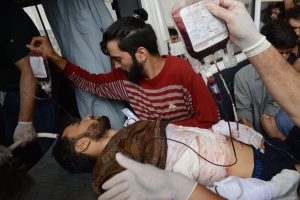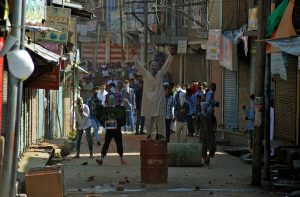By Mohd Tahir Ganie (@TahirFiraz)
All photos are from photo journalist Sameer Mushtaq.
This summer I visited Kashmir to collect important data for my research thesis, and also to see my family. While it took a while clearing needless bureaucratic hassles to get access to hardbound newspaper archives, I was optimistic in getting my work done gradually. But soon my optimistic self was to be overwhelmed by the most significant political event in the recent Kashmiri history: on 8th July a local rebel leader Burhan Wani was killed and immediately spontaneous street protests erupted in entire Kashmir valley.
Burhan Wani, who had joined an indigenous rebel group as a teenager, was quite popular – in large part due to his good-looks and social media persona built over the years. He attracted lot of Kashmiris, particularly youth, and also drew some of them to militant ranks; and that is why when he was killed, at the young age of 22, in a “military encounter” in south Kashmir, his funeral procession was largely thronged by young men and women. By some estimates his funeral procession, which was held in his hometown Tral, around 50 km from the capital city Srinagar, was attended by over 200,000 mourners – one of the largest for any Kashmiri ever. As a mark of solidarity, and political convention among pro-independence Kashmiri dissidents, all business establishments, government offices, transport, educational institutions were closed in the wake of his death, which brought most economic and other day to day activities to a virtual halt, including my data collection work.
But explosive situations aren’t new to Kashmir, for Kashmiris have been living under constant pressures of the raging conflict and concomitant militarization and political upheavals since early 1990’s; and also 2008 and 2010 mass protests occurred not so long ago. However, what was certainly different this time around was the emotional intensity and spread of these Intifada like protests. While in 2008 and 2010, people of urban centres were more active protest participants, this time the protest wave had swept not only the entire Kashmir valley – traditionally the centre of perpetual political agitations – but also reached relatively peaceful Chenab area in the Jammu region. And yet, what was also different during this time was the sheer scale and appalling brutality of state violence. As many commentators in media have already described, the current state violence against protestors in Kashmir has been unprecedented. In its report, a fact-finding team of the People’s Union for Civil Liberties (PUCL), which spent a week in Kashmir (October 14-22), made following observations: “The government responded by heavy and forceful military clampdown which resulted in a continuing spate of killings, injuries and arrests of people which continues unabated almost every day till the present.”
And, giving details about the human cost of such “heavy and forceful military clampdown” against Kashmiri civilians, the PUCL reported that from 9th July to 15th October, “the total number of civilians killed by the police and the security forces was 101…[and] It was reported that 12 people died due to pellets fired by the forces. It was also learnt that 1 policeman too was killed in mob violence.”
The report further revealed that, “a total of 15,000 persons were injured in this period with 12, 344 being admitted in various hospitals. About a thousand persons were injured in the eye due to pellets resulting in 300 cases of blinding, which included a large proportion of school going children.”
Witnessing the Horrors of Brutal State Action
The morning of 9th July was eerily silent in Pampore, my hometown, because curfew was promptly imposed there. However, mass protests had engulfed most towns and villages. I rushed to the local hospital to see an acquaintance of mine who had been injured in police action when he tried to reach Tral to join funeral, and it was there in the Emergency ward that I saw pellet-ridden bodies for the first time. By noon, ambulance after ambulance arrived with over dozen grievously injured protestors. One of them died after a party of feared Special Task Force (STF) violently barged into the hospital and roughed up his attendants inside the ambulance. Everyone was left in utter shock. Soon, reports began to come that ambulances were being deliberately targeted by paramilitary men and at some places government forces had barged into hospital premises and thrashed medical staff and injured patients. As protests continued unabated, many houses were ransacked, private vehicles smashed and agricultural produce destroyed. It looked like a planned state tactic to crush the uprising.
“Scars of Pellet Gun”
While listening to conversations I realized “pellet” was the most frequently used term on streets and homes and, also, in media. There was a reason. Pellet gun was never used at a scale as it was during the summer 2016; and the damage to human bodies it caused was unprecedented as PUCL reported. As such, its use against Kashmiri protestors has been opposed by many rights groups, including Amnesty, which described this so-called non-lethal weapon as “inherently inaccurate and indiscriminate” and hence not appropriate for policing protests. Even some Indian legislators on the floor of the Indian parliament voiced their opposition against pellet guns. “Shoot the people but do not use pellet guns. Pellet Guns are worse than live bullets. It is worse than killing people,” a senior India politician said in the Parliament on Aug 10. But despite much opposition the government did not stop using them, and still insist on its necessity. Central Reserve Police Force (CRPF), the Indian paramilitary force, which remains deployed in huge numbers on Kashmiri streets – along with army and police – to crush the ongoing protests, has justified use of pellet guns, as according to the CRPF affidavit, only other alternative for it is “to open fire with rifles, which may cause more fatalities.” In response to a public litigation, CRPF revealed that it has fired 1.2 million pellets in the first 32 days of street protests. Each cartridge of pump-action shot gun contains lead pellet, which disperse into hundreds of tiny pieces, and when aimed from close range these pellets can penetrate soft tissues of the targeted body. The extent of damage caused by pellets shots, especially to eyes, has been widely documented in press reports. One of the detailed and descriptive reportages on this terrible phenomenon was Ellen Barry’s story in The New York Times “An Epidemic of Dead Eyes in Kashmir as India Uses Pellet Guns on Protestors” (28 August).
 And The Deadlock Continues…
And The Deadlock Continues…
Indian media frames the current uprising in Kashmir as a law and order issue or Pakistan orchestrated problem and indiscriminately uses the term “mob violence” to describe the street protests and deliberately focuses on stone-pelting incidents. As a result, Indian media is despised in Kashmir. Its framing not only obscures the fact that the government forces used excessive force to thwart even peaceful congregations, but provides a cover for punitive state actions. In what The Indian Express (Oct 21) describes as “the biggest crackdown in two decades” the state authorities in Kashmir have arrested at least 7000 people, with around 500 of them under Public Safety Act (PSA), which Amnesty International calls as a “lawless law” (because a person arrested under PSA remains in custody without trail for at least 6 months). Among the arrested are 85 minors, some of them on sedition charges.
The Indian government blamed Pakistan for the protests, refusing to engage it on Kashmir, while as Pakistan publicly assured strong diplomatic and political support to what its calls as the “Kashmiri freedom struggle.” In the hope to bring much needed international attention to their cause and make some headway politically, Kashmiris continue to adhere to protest calendars issued week after week by Hurriyat, an amalgam of pro-independence parties. The deadlock seems to not go away.
But as evident in the mass participation of people in the current anti-India uprising, the political aspiration of Kashmiris for Azadi (independence) does not seem to wane despite long spells of military crackdown that was unleashed to crush the Kashmiri armed movement in the early 1990’s and then again to suppress the 2008 and 2010 pro-independence protests. And still, rather than responding politically – a measure also advocated by many senior Indian parliamentarians, diplomats, and journalists – to the political demands of Kashmiris the government of India has chosen a hard approach with the sole objective to bring the writ of the state back on the streets of Kashmir. Although, a delegation of Indian Parliamentarians went to Kashmir, but it didn’t help in breaking the ice as Kashmiri pro-independence leaders refused to meet the delegates, arguing that, first, the delegation did not have the mandate, and second, the Indian state has discredited the institution of dialogue because, in the past, similar delegations visited Kashmir during the times of political crisis but nothing concrete followed after that. And the deadlock continues…



